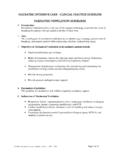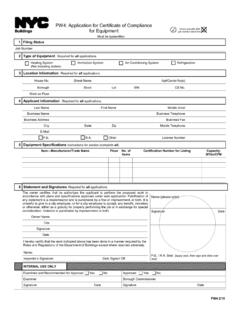Transcription of Health Technical Memorandum 03-01 Part B
1 Health Technical Memorandum 03-01 Specialised ventilation for healthcare premises Part B: The management, operation, maintenance and routine testing of existing healthcare ventilation systemsClassification: OfficialPublications approval reference: PAR38iiHealth Technical Memorandum 03-01 Specialised ventilation for healthcare premises Part BiiPrefaceAbout Health Technical MemorandaHealth Technical Memoranda (HTMs) give comprehensive advice and guidance on the design, installation and operation of specialised building and engineering technology used in the delivery of healthcare. The focus of Health Technical Memorandum guidance remains on healthcare-specific elements of standards, policies and up-to-date established best practice. They are applicable to new and existing sites, and are for use at various stages during the whole building usage in Technical guidanceIn HTMs and HBNs, modal verbs such as must , should and may are used to convey notions of obligation, recommendation or permission.
2 The choice of modal verb will reflect the level of obligation needed to be following describes the implications and use of these modal verbs in HTMs/HBNs (readers should note that these meanings may differ from those of industry standards and legal documents): Must is used when indicating compliance with the law. Should is used to indicate a recommendation (not mandatory/obligatory), among several possibilities or methods, one is recommended as being particularly suitable without excluding other possibilities or methods. May is used for permission, to indicate a course of action permissible within the limits of the HBN or usage examples All publicly-funded organisations must ensure that all contracts established to collect and treat waste conform to the Public Contracts Regulations.
3 [obligation] This guidance is not mandatory (unless specifically stated). However, any departures/derogations from this HTM including the measures implemented should provide a degree of safety not less than that achieved by following the guidance set out in this HTM was prepared prior to the COVID-19 pandemic caused by the severe acute respiratory syndrome coronavirus 2 (SARS-CoV-2). It has been reviewed against the known transmission evidence available at the time of publication. ventilation is one of many mitigations against the virus and should be part of a package of infection prevention and control measures. The ventilation rates recommended in this document are likely to provide a lower risk environment for COVID-19 airborne transmission. Emerging evidence will continue to be reviewed as and when All low voltage (LV) distributions should be configured as TN systems.
4 [recommendation] Alcohol hand gels that do not contain siloxanes may be rinsed out and the packaging recycled or placed into the municipal waste stream. [permission] Shall , in the obligatory sense of the word, is never used in current derogations from the Technical GuidanceHealthcare facilities built for the NHS are expected to support the provision of high-quality healthcare and ensure the NHS Constitution right to a clean, safe and secure environment. It is therefore critical that they are designed and constructed to the highest and most appropriate Technical standards and guidance. This applies when organisations, providers or commissioners invest in healthcare accommodation (irrespective of status, for example Foundation and non-Foundation trusts). Statutory standards plus Technical standards and guidance specific to NHS facilities: Health Building Notes Health Technical Memoranda Complete list of NHS estates-related guidanceThe need to demonstrate a robust process for agreeing any derogation from Technical Guidance is a core component of the business case assurance process.
5 The starting point for all NHS healthcare projects at Project Initiation Document (PID) and/or Strategic Outline Case (SOC) stage is one of full to standards will potentially jeopardise business case approval and will only be considered in exceptional circumstances. A schedule of derogations will be required for any project requiring external business case approval and may be requested for those that have gone through an internal approvals process. While it is recognised that derogation is required in some cases, this must be risk-assessed and documented in order that it may be considered within the appraisal and approval process. Derogations must be properly authorised by the project s senior responsible owner and informed and supported by appropriate Technical advice (irrespective of a project s internal or external approval processes).
6 Sustainability and Net Zero Carbon targetsHealthcare provision is a significant contributor to the UK s carbon footprint. (In 2019, this was estimated to be around of our greenhouse gases.) Accordingly, all NHS organisations have their part to play in meeting Net Zero Carbon targets alongside other sustainability measures. In January 2020, Health chief Sir Simon Stevens announced three steps the NHS will take during 2020 to tackle this problem: NHS England has established an expert panel to chart a practical route map to enable the NHS to get to net zero . The panel will submit an interim report to NHS England in summer 2020 and a final report ahead of the November 2020 UN Climate Change Conference (COP26) in Glasgow. The panel will consider changes the NHS can make in its own activities; in its supply chain; and through wider partnerships; the NHS Long Term Plan commits to better use of technologies to make up ivHealth Technical Memorandum 03-01 Specialised ventilation for healthcare premises Part Bivto 30 million out-patient appointments redundant, sparing patients thousands of unnecessary trips to and from hospital.
7 It is estimated that billion road miles each year are from patients and their visitors travelling to the NHS; the panel will consider changes that can be made in the NHS s medical devices, consumables and pharmaceutical supply, and areas the NHS can influence such as the energy sector as the Health service moves to using more renewable specific ventilation -related measures, see the Net Zero Carbon section on page summaryvExecutive summaryPreambleHealth Technical Memorandum 03-01 Specialised ventilation in healthcare premises is published in two parts:Part A: The concept, design, specification, installation and acceptance testing of healthcare ventilation B: The management, operation, maintenance and routine testing of existing healthcare ventilation documents give comprehensive advice and guidance on the legal requirements, design implications, maintenance and operation of specialised ventilation in healthcare premises providing acute care.
8 The use of these premises is very intense, the occupancy level high and the patients may be particularly susceptible to airborne infection risks. Their condition may also require close control of the ventilation of non-healthcare facilities within the hospital curtilage should be designed to suit the application and specific guidance relating to the activity should be followed, for example pharmacy, sterile services department, etc. However, as they are on the hospital site, the means of providing ventilation should not adversely impact upon the hospital (for example, evaporative cooling towers should not be installed, sound levels should be appropriate and if the facility is within or attached to an area accessed by patients, their needs and the risk of airborne contamination should be considered).
9 In other types of healthcare facility that are outside of the hospital curtilage, for example GP practices, Health centres, minor injuries units, dental, ophthalmic and podiatry clinics, mental Health facilities, respite and long stay care homes and hospices, etc, a risk assessment of the nature of the treatment being delivered, condition of the patients and intensity of use needs to be undertaken by those responsible for the facility in order to determine the extent to which this guidance will be guidance contained in Part A of this Health Technical Memorandum applies to new installations and major refurbishments of existing installations and should be considered as the standard to be guidance contained in Part B of this Health Technical Memorandum applies to all ventilation systems installed in healthcare premises irrespective of the age of the installation and should be considered as the standard to be Technical Memorandum 03-01 (2021) supersedes all previous versions of Health Technical Memorandum 03-01 Specialised ventilation in healthcare premises (2007).
10 It also supersedes HTM 2025 (1994) and DV4 (1983).viHealth Technical Memorandum 03-01 Specialised ventilation for healthcare premises Part BviWho should use this guidance?This document is aimed at specifiers, designers, suppliers, installers, estates and facilities managers and operations. Elements of the document will also be relevant to managers concerned with the day-to-day management of healthcare facilities and senior healthcare changes since the 2007 edition Design information for specific healthcare applications has been revised and information on the reason for ventilation given. For example, endoscopy rooms are now negative pressure to contain and remove odours and manage airborne risks to staff. These endoscopy-specific risks ( waste anaesthetic gases and pathogenic material (for example, multi-drug-resistant tuberculosis) discharged by the patient during the procedure being undertaken) were identified prior to the SARS-CoV-2 pandemic.












